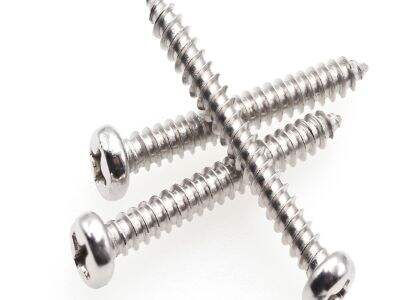Hi there. So, are you ready to discuss screws? You might have noticed that there are various types of screws for various jobs. Screws are very useful tools. They can assist us by constructing furniture or repair broken toys. Understand screws & choosing the right one for your project Now, let's get going and explore the world of screws.
What are Screws?
Screw — small metallic tools that have twisty shape. They help keep things tacked down tightly. There are many types of screws, each designed for a particular application with distinct materials. Some screws have a flat bottom, while others are sharpened to help them bite into materials. Some screws are long while others are short, depending on what is needed for your project. Wood screws, sheet metal screws, and machine screws are probably the most commonly found types of screws.
Wood Screws: These screws are tapered and pointed at one end and are better used for wood projects. They are available in different sizes, so you need to choose the right size to use as per the type of wood you are using. The correct size allows the screw to grip the wood parts more effectively.
Sheet Metal Screws: These screws work well for thin pieces of metal, such as whenever fixing appliances or working on ductwork. This tek screws is because they have a flat underside and a sharp tip, helping it push through the metal without bracing.
Machine Screws: Unlike wood screws, machine QD screws are used in applications you may want to be able to dismantle at a later date, such as electronics. They can also be used to fasten wood and metal or plastic materials.
Why you choose the right screw matters
It is crucial to select the appropriate screw. If you use a screw that's too short, it won't bind everything together correctly, and your project could fall apart. The screw can also hurt the material, or even poke out the other side, which can be dangerous. Using an incorrect screw type can also cause issues. For example, a wood screw used in metal can break the screw or crack the metal, which could ruin your project.
How to Keep Your Project Safe
Go through the following steps diligently so that your project is safe and secure.
The screw that you will be using about what the material. That means seeing if you dealing with wood, metal or plastic.
Choose the appropriate size and length of screw for your material. So you want to make sure it fits justa right so it can do its job properly.
Drill bit must correspond to size of the screw. The set screw set drill bit is the instrument you use to create an opening for the screw to fit into and can also be the same size as the screw for a successful operation.
Then always pre-drill a small hole before inserting the screw. This procedure is known as pre-drilling. When you drive the screw in, it prevents the material from splitting or cracking.
Tighten all screws to secure everything. When you get your screw into place make sure it is well fixed and properly tightened, of course taking care to not over-tighten it.
Do’s and Don’ts of Using Screws
Here are a few tips to keep in mind when using screws in your projects:
Do's:
Choose the correct screw type for your project. It helps that your project will be solid and secure.
Select a drill bit to match the size of the screw. This aids the screw in entering without issue.
Drill a pilot hole for your screw. Doing this is crucial to keep your materials safe.
Tighten the Screws down nicely, but don’t overdo it. You want it snug, but not so tight that it destroys the material.
Use the appropriate screwdriver for safety of the screw. This should make sure the screw does not become damaged as you create.
Don'ts:
Don’t use the wrong screw type. If you use the incorrect screw, you might encounter issues with your project.
If your drill bit is too big or too small, don’t use it. This can cause difficulty in securing the screw properly.
Do not pass over making a hole first. It is necessary to pre-drill to prevent your materials from cracking.
Don’t over-tighten the screw. If you make it too tight it can break or trash your project.
Avoid a toolbox that’s missing some key players. If the fit is poor, it will strip the head of the screw and be difficult to remove later.
Everything You Need to Know
To sum up, screws play an extremely significant role in home projects. They are used in various applications. For example, there are screws designed for wood, metal, and plastic. Always use the proper kind and size of screw for your project and make a hole first. DO NOT over-tighten a screw or use the wrong screwdriver. Keep these tips in mind and your projects will be protected, secured, and running hot.
We hope you enjoyed learning about screw and how to use them. Time to take out your screwdriver and build something awesome. Happy DIY-ing.












































